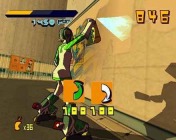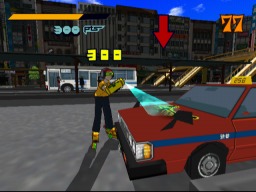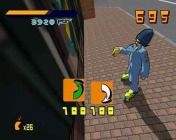 With most retailers and online
stores clearing out their remaining inventory of Sega's Dreamcast, many die-hard
gamer and collectors out there are discovering a hidden gem in the console's
library; Jet Grind Radio. While the game didn't sell well enough at launch to
save the console, it's definitely worth seeking out. The game's unique
look and feel remain largely unmatched to this day, and make it one of the most
original and addictive Dreamcast games on the market. In Jet Grind Radio, you
play as one of a group of outlaw roller-bladders called the GG's. These hip,
young rebels are trapped in a
futuristic city that oppresses creativity, especially music and tagging. The
cast of characters is quite cool and include Beat, a cool young kid in a yellow
shirt, or a mysterious girl Gum who's sexiness is only matched by her hipness.
As you progress through the game, you can recruit and unlock more cool
characters such as the hip-hopper Tag to join the GG's gang. To help you stay
motivated, the game's funky DJ Professor K appears between levels to update his
listeners on the status of the gangs and the police crackdown on them.
During the game, your main goal is to battle rival gangs to control the various
areas of Tokyoto. You mark your turf by tagging your sign in certain sections of
your area. Once you have completed one tag, you have to find the next one.
Sounds simple except the levels can be
quite large and tag points can be hidden in obscure sections. Some of the areas to mark require you to perform
elaborate stunts to reach them such as large jumps. JGRís gameplay system
offers a surprisingly large number of tags, and completing these makes for a
unique challenge.
With most retailers and online
stores clearing out their remaining inventory of Sega's Dreamcast, many die-hard
gamer and collectors out there are discovering a hidden gem in the console's
library; Jet Grind Radio. While the game didn't sell well enough at launch to
save the console, it's definitely worth seeking out. The game's unique
look and feel remain largely unmatched to this day, and make it one of the most
original and addictive Dreamcast games on the market. In Jet Grind Radio, you
play as one of a group of outlaw roller-bladders called the GG's. These hip,
young rebels are trapped in a
futuristic city that oppresses creativity, especially music and tagging. The
cast of characters is quite cool and include Beat, a cool young kid in a yellow
shirt, or a mysterious girl Gum who's sexiness is only matched by her hipness.
As you progress through the game, you can recruit and unlock more cool
characters such as the hip-hopper Tag to join the GG's gang. To help you stay
motivated, the game's funky DJ Professor K appears between levels to update his
listeners on the status of the gangs and the police crackdown on them.
During the game, your main goal is to battle rival gangs to control the various
areas of Tokyoto. You mark your turf by tagging your sign in certain sections of
your area. Once you have completed one tag, you have to find the next one.
Sounds simple except the levels can be
quite large and tag points can be hidden in obscure sections. Some of the areas to mark require you to perform
elaborate stunts to reach them such as large jumps. JGRís gameplay system
offers a surprisingly large number of tags, and completing these makes for a
unique challenge.
While the rival gangs are after you, the police want your head even more. On
each level, you have to watch out for the police who are
looking to shut your gang down. While the initial few tags on each level can
usually be completed without interference, once you've completed enough tags,
the psychotic police chief Captain Onishima will be agitated further by your
presence and come after you with guns blazing. Or tanks. Or Helicopters. The
definitely adds conflict to the experience, but you can escape their pursuit at
times by jumping or grinding to an out-of-the-way area. Once they corner you,
they'll sap your energy. The clashes with them are intense, with the player
usually having to outrun a number of cops simultaneously. Not the easiest task
in the world. Your success will only enrage the cops, and as you gain more fame, they'll
hatch ever more
elaborate attempts to capture you. The early levels are fairly easy, but the
game becomes increasingly difficult as you progress. The gameplay's appeal is further enhanced by
the intuitive controls which are simple and very easy to learn, thanks to a
series of tutorial/challenge levels that begin the game. Grinding and jumping is
ridiculously easy to perform, and allow you to jump right in without of effort.
Making the game more accessible are the level designs, which are fairly
straightforward. Mastering the timing from performing stunts and skating around to tagging walls
will take some time but once you get used to it,
the controls become second nature making a for an irresistibly fun game that you
canít put down.
 Jet Grind Radioís
incredible graphics are quite impressive and utilize cel-shading successfully in
a manner that doesn't feel like a gimmick. While it's been used in many other
titles since, JGR still looks unique. It creates an brilliant fusion of
anime and hip-hop that seems like an edgy cartoon come to life. The gameís exaggerated characters and
environments creating a heightened surreal experience few other games can match.
It doesn't hurt that the silky smooth frame rates and evocative environments
create a hyper sensation that defies easy categorization, even today nearly four
years after release. JGR takes place in an
evocative futuristic metropolis called Tokyoto. This isn't some static
environment, instead the developers created a teeming urban environment full of
life, passion and creativity. The streets are filled with pedestrians and each
level in JGR bustles with energy throughout. The cell
shading techniques with their bright colors make the game look completely unique
and incredible Ė add in the light sourcing and you have an absolutely amazing
environment in which to skate. JGR moves along at a smooth silky pace
that is fast and consistent. Itís incredible graphics engine
is only enhanced by the incredible animation of the main characters who
move realistically yet with an exaggerated sense of reality that gives the game
a unique edge. Additionally, the design and imagination in the gameís environments are
unmatched - everything feels
natural and consistent Ė the clothing the characters wear, the signs on the streets,
the exaggerated simplicity of the objects in its cartoon world, nothing since
possibly the first Wipeout has had such an immediate and unforgettable visual
impact and is proof that there was a lot of power under the Dreamcast's white
hood. Jet Grind Radio is
obviously a visual knockout punch but the music in the game is also incredible.
Very rarely has a gameís music been so integral and enjoyable, while
complimenting the action perfectly. The alternative pop and hip-hop tracks are instantly memorable and
enhance the Ďoutlawí feel of the title in a way that feels incredibly fresh
and innovative. JGRís soundtrack remains one of the high-water marks in the
industry, it's a shame that few titles since have matched the title's visionary
fusion of art and sound.
Jet Grind Radioís
incredible graphics are quite impressive and utilize cel-shading successfully in
a manner that doesn't feel like a gimmick. While it's been used in many other
titles since, JGR still looks unique. It creates an brilliant fusion of
anime and hip-hop that seems like an edgy cartoon come to life. The gameís exaggerated characters and
environments creating a heightened surreal experience few other games can match.
It doesn't hurt that the silky smooth frame rates and evocative environments
create a hyper sensation that defies easy categorization, even today nearly four
years after release. JGR takes place in an
evocative futuristic metropolis called Tokyoto. This isn't some static
environment, instead the developers created a teeming urban environment full of
life, passion and creativity. The streets are filled with pedestrians and each
level in JGR bustles with energy throughout. The cell
shading techniques with their bright colors make the game look completely unique
and incredible Ė add in the light sourcing and you have an absolutely amazing
environment in which to skate. JGR moves along at a smooth silky pace
that is fast and consistent. Itís incredible graphics engine
is only enhanced by the incredible animation of the main characters who
move realistically yet with an exaggerated sense of reality that gives the game
a unique edge. Additionally, the design and imagination in the gameís environments are
unmatched - everything feels
natural and consistent Ė the clothing the characters wear, the signs on the streets,
the exaggerated simplicity of the objects in its cartoon world, nothing since
possibly the first Wipeout has had such an immediate and unforgettable visual
impact and is proof that there was a lot of power under the Dreamcast's white
hood. Jet Grind Radio is
obviously a visual knockout punch but the music in the game is also incredible.
Very rarely has a gameís music been so integral and enjoyable, while
complimenting the action perfectly. The alternative pop and hip-hop tracks are instantly memorable and
enhance the Ďoutlawí feel of the title in a way that feels incredibly fresh
and innovative. JGRís soundtrack remains one of the high-water marks in the
industry, it's a shame that few titles since have matched the title's visionary
fusion of art and sound.
While Jet Grind Radio's
aesthetics were incredible, itís challenging and addictive gameplay where Jet Grind Radio
really stands apart, and stands the test of time. At first, it seems that JGR
shares some superficial elements with Tony Hawk's Pro Skater and its ilk, but
the game's unique 'tagging' elements and the run-ins with the police give it a
unique personality all its own. What's most impressive about the game is its
forward-looking design, which anticipated the rise of other Free-form titles
like GTA. JGR expansive levels and non-linear goals allows players to go
anywhere on the level as they try and locate the tag spots. Once the player is
in front of these areas, they can spray-paint their gang's tag over the existing
sign. This is done using a series of motions on the D-pad that mimic the use of
a spray can. This is a small touch, but it definitely makes you feel more
in-tune with your character. While tags on the early levels are relatively easy
to make, the complexity of some of the larger graffiti designs in later levels
makes them quite challenging to complete. Intially, you only need a single can
of paint for each tag, but later on, there are large murals that require
multiple motions and movements, not to mention many spray cans to complete.
While you can explore the levels freely, you also have to contend with a timer,
that gives you a set amount of time to complete each level. The timer seems
endless on the early stages, but later levels throw more challenges at you and
there isn't as much time for sight-seeing.
 What really makes the game
special aren't these above-mentioned elements, but the way that Jet Grind Radio
fuses them so effortlessly to create one of the more unique experiences on the
Dreamcast. The game's visuals fit the action perfectly, with outstanding,
creative character designs that make for appealing protagonists. The game's
consistency lends itself to the environments as well, which creates a cohesive
and exciting world throughout. It isn't all flash, with many expansively
impressive areas to explore, which should keep players occupied for hours. Jet
Grind Radio's play balance offers an excellent array of speedy action, cool
grinding stunts and wild pursuits, mixed with the ever-ticking clock and the
need to complete your tags before time runs out. In total, this is one of the
most addictive, creative and interesting titles released on the Dreamcast.
Sadly, the game's brilliance was largely ignored despite having all the elements
of a successful release. The game's lack of success is all the more baffling
considering that "extreme" sports titles were all the rage at the
time. Obviously, the Dreamcast itself wasn't as successful as Sega and many
gamers had hoped, but Jet Grind Radio had other things going against it. While
it was an amazing achievement for its time, from both a technical and aesthetic
viewpoint, many gamers probably felt it was too 'weird', especially with the odd
hip-hop style graphics, graffiti-tagging and its J-pop soundtrack. Despite the
game's failure in the marketplace, Sega persisted with the franchise, releasing
an excellent sequel on the Xbox and a semi-decent remake of the original game on
the Game Boy Advance. Still, it seems the franchise has slipped under the radar
of most gamers. The good news is that with the discounting of Dreamcast consoles
and games at many retailers means that Jet Grind Radio may finally be able to
reach the audience it deserves.
What really makes the game
special aren't these above-mentioned elements, but the way that Jet Grind Radio
fuses them so effortlessly to create one of the more unique experiences on the
Dreamcast. The game's visuals fit the action perfectly, with outstanding,
creative character designs that make for appealing protagonists. The game's
consistency lends itself to the environments as well, which creates a cohesive
and exciting world throughout. It isn't all flash, with many expansively
impressive areas to explore, which should keep players occupied for hours. Jet
Grind Radio's play balance offers an excellent array of speedy action, cool
grinding stunts and wild pursuits, mixed with the ever-ticking clock and the
need to complete your tags before time runs out. In total, this is one of the
most addictive, creative and interesting titles released on the Dreamcast.
Sadly, the game's brilliance was largely ignored despite having all the elements
of a successful release. The game's lack of success is all the more baffling
considering that "extreme" sports titles were all the rage at the
time. Obviously, the Dreamcast itself wasn't as successful as Sega and many
gamers had hoped, but Jet Grind Radio had other things going against it. While
it was an amazing achievement for its time, from both a technical and aesthetic
viewpoint, many gamers probably felt it was too 'weird', especially with the odd
hip-hop style graphics, graffiti-tagging and its J-pop soundtrack. Despite the
game's failure in the marketplace, Sega persisted with the franchise, releasing
an excellent sequel on the Xbox and a semi-decent remake of the original game on
the Game Boy Advance. Still, it seems the franchise has slipped under the radar
of most gamers. The good news is that with the discounting of Dreamcast consoles
and games at many retailers means that Jet Grind Radio may finally be able to
reach the audience it deserves.
>
Related Reviews
Toejam & Earl III (Xbox)
Jet Set Radio Future (Xbox)
Rez (PS2)

